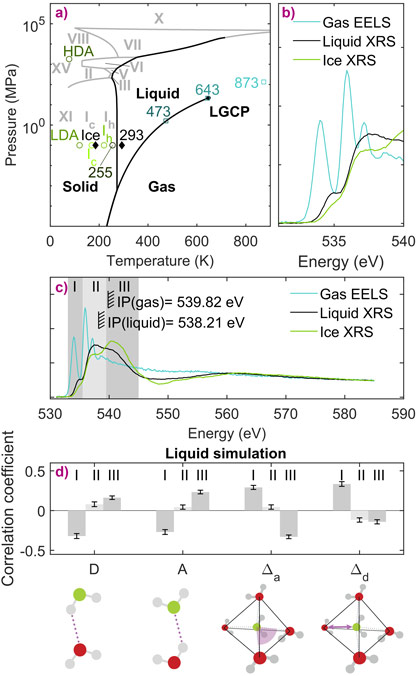- Home
- News
- Spotlight on Science
- Compatibility of...
Compatibility of quantitative X-ray spectroscopy with continuous distribution models of water at ambient conditions
10-04-2019
A new multi-method study including hard X-ray scattering at beamline ID20 proves that X-ray spectroscopic data of liquid water can be fully and consistently described by continuous-distribution models of near-tetrahedral water at ambient conditions.
Water at ambient conditions is the matrix of life and chemistry. It behaves anomalously in many of its properties with respect to other liquids. Since Wilhelm Conrad Röntgen [1], two distinct separate phases have been argued to coexist in liquid water, competing with a view of a single-phase liquid in a fluctuating hydrogen bond network – the continuous distribution model. Over time, X-ray spectroscopic results have repeatedly been interpreted in support of Röntgen's postulate.
New quantitative X-ray spectroscopic data, collected at the ESRF, Swiss Light Source, and Bessy-II synchrotrons, were all found to be fully and consistently described with continuous distribution models of near-tetrahedral liquid water at ambient conditions. The research revealed also new conceptual insights into the statistical nature of the liquid system and its spectra.
Oxygen K-edge spectra from self-absorption-free X-ray Raman scattering spectroscopy of ambient liquid water and solid ice were taken at the large-solid-angle spectrometer at the ESRF beamline ID20 (Figure 1). In conjunction with electron energy loss spectroscopy data of the gas phase, the recorded data revealed 1.74 ± 2.1% hydrogen bonds per molecule.
In this multi-method study, high-resolution oxygen K-edge resonant inelastic X-ray scattering spectra of liquid water was subsequently studied. A single dominant mode without substructure was found at the highest resolving power achieved so far of > 10,000. Two distinct modes would be supportive for a heterogenous or two-phase structure.
Finally, X-ray emission spectra and density functional theory calculations revealed the prominent role of excited state dynamics for the formation of the split 1b1 peak in the emission spectrum. The branching ratio of this peak has previously been used as an argument for the two-phase models. However, the new experimental data show the stark photon-energy dependence of the emission lines: truly non-resonant X-ray emission spectra of liquid water show a branching ratio close to that previously observed in ice by using an X-ray tube. In line with previously published results, the researchers found the simulation with dynamics to be needed for the split emission peak. In addition, a statistical analysis revealed that small effects from the structure can still be expected in the X-ray emission spectrum.
This finding supports the overall rationale of computational simulations used widely in chemistry and bio-sciences, which would have needed revision if the two-phase hypothesis had been proven correct.
Principal publication and authors
Compatibility of quantitative X-ray spectroscopy with continuous distribution models of water at ambient conditions, J.Niskanen (a,b), M. Fondell (b), Ch.J. Sahle (c), S. Eckert (d,a), R.M. Jay (d,a), K. Gilmore (c), A. Pietzsch (a), M. Dantz (e), X. Lu (e), D.E. McNally (e), T. Schmidt (e), V. Vaz da Cruz (f,a), V. Kimberg (f,g), F. Gel’mukhanov (f,g), A. Föhlisch (a,d), Proceedings of the National Academy of Sciences 116, 4058-4063 (2019); doi: 10.1073/pnas.1815701116.
(a) Institute for Methods and Instrumentation for Synchrotron Radiation Research, Helmholtz Zentrum Berlin für Materialien und Energie, Berlin (Germany)
(b) Department of Physics and Astronomy, University of Turku, Turun Yliopisto (Finland)
(c) ESRF
(d) Institut für Physik und Astronomie, Universität Potsdam, Potsdam-Golm (Germany)
(e) Swiss Light Source, PhotonScience Division, Paul Scherrer Institut, Villigen (Switzerland)
(f) Theoretical Chemistry and Biology, Royal Institute of Technology, Stockholm (Sweden)
(g) Institute of Nanotechnology, Spectroscopy and Quantum Chemistry, Siberian Federal University, Krasnoyarsk (Russia)
References
[1] W.C. Röntgen, Über die Constitution des flüssigen Wassers", Annalen der Physik 281(1), 91-97 (1892).
Top image: A homogeneous, single-phase-liquid model is sufficient to understand liquid water at ambient conditions.




